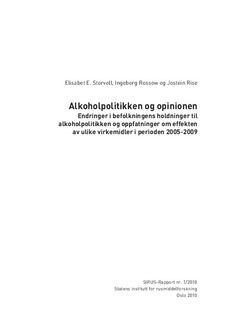| dc.contributor.author | Storvoll, Elisabet | |
| dc.contributor.author | Rossow, Ingeborg | |
| dc.contributor.author | Rise, Jostein | |
| dc.date.accessioned | 2015-01-29T15:11:28Z | |
| dc.date.accessioned | 2015-02-11T19:50:18Z | |
| dc.date.available | 2015-01-29T15:11:28Z | |
| dc.date.available | 2015-02-11T19:50:18Z | |
| dc.date.issued | 2010 | |
| dc.identifier.citation | SIRUS-rapport. 68 p. Statens institutt for rusmiddelforskning, 2010 | |
| dc.identifier.isbn | 978-82-7171-329-4 | |
| dc.identifier.uri | http://hdl.handle.net/11250/276042 | |
| dc.description | - | |
| dc.description.abstract | Hovedmålet med denne rapporten har vært å beskrive endringer fra 2005 til 2009 i befolkningens (1) holdninger til alkoholpolitikken og (2) oppfatninger om effekten
av ulike virkemidler for å begrense alkoholrelaterte skader og problemer. I tillegg har vi beskrevet hvordan holdningene og oppfatningene varierer etter kjønn, alder, utdannings
nivå og drikkefrekvens.
Rapporten bygger på data fra seks befolkningsundersøkelser som Helsedirektoratet bestilte fra Synovate (tidligere MMI) i perioden 2005-2009. Undersøkelsene ble gjennomført på web, og svarprosenten var mellom 41 og 55 %. Analysene ble
begrenset til 20-69-åringer (total N = 8
256), og datasettene ble vektet med hensyn til kjønns- og aldersfordeling.
Studien tyder på at det har vært en bevegelse i efolkningens holdninger til sentrale deler av den norske alkoholpolitikken. Analysene viser at det var større oppslutning om restriktive alkoholpolitiske virkemidler på slutten av perioden 2005-2009 enn i begynnelsen. Det var for eksempel færre som var enige i at alkohol er for dyrt, at vin
bør selges i butikk, at aldersgrensene er for høye og at promillegrensene er for strenge.
Oppfatningene om effekten av sentrale virkemidler for å begrense alkoholrelaterte skader og problemer endret seg også. Det var en økning i andelen som trodde at høye
priser og tilgjengelighets begrensninger i stor grad kunne bidra til å begrense skadevirkningene av alkohol. På den annen side var det en nedgang i andelen som
trodde at aldersgrenser for kjøp av alkohol og promilleregler for bilkjøring hadde en
slik effekt. Andelene som trodde at foreldres grense
setting og informasjon og holdnings
skapende arbeid i stor grad kunne bidra til å begrense skadevirkningene, var stabil.
Oppslutningen om en restriktiv alkoholpolitikk var generelt sett størst blant kvinner, de eldste respondentene, de med høyest udanning og de som ikke, eller bare sjelden drakk
alkohol. De samme undergruppene var også mest tilbøyelige til å tro at de alkohol -
politiske virkemidlene det ble spurt om, var effektive for å begrense skadevirkningene av alkohol. Selv om holdningene til alkoholpolitikken og oppfatningene om effekt av | |
| dc.description.abstract | The main object of this report was to describe changes occurring between 2005 and 2009 in the public’s (1) attitudes to alcohol policy and (2) perceptions of the effect of different measures aimed at limiting alcohol-related harm and problems. We have also described how attitudes and perceptions vary by gender, age, education level and drinking frequency.
The report is based on data derived from six surveys commissioned by the Norwegian Directorate of Health from Synovate (formerly MMI) in the period 2005?09. The surveys were conducted via the Internet and the response rate varied between 44 and 55 %. The analyses were limited to 20?69-year-olds (total N = 8,256), and the data sets were weighted with regard to gender and age distribution.
The study indicates changes in the public’s attitude to key elements of Norwegian alcohol policy. The analyses show higher support for restrictive policy measures at the end of the period 2005?09 than at the beginning. For instance, fewer respondents agreed that alcohol was too expensive, that wine should be sold in grocery shops, that the age limits were too high and that legal BAC levels for driving were too low. Perceptions regarding the impact of key measures to limit alcohol-related harm also changed. There was a rise in the proportion that believed high prices and accessibility restrictions could significantly limit alcohol-related harm. On the other hand, fewer believed that minimum legal ages for purchasing alcohol and legal BAC levels for driving had such an effect. The percentages that believed that parental restrictions and information and efforts to change attitudes had a significant harm-limiting effect remained stable.
Support for a restrictive alcohol policy was generally highest among women, the oldest respondents, those with the highest education levels, and those who drank alcohol only rarely or never. These sub-groups were generally also more likely to believe that the various alcohol policy measures in question were effective in limiting alcohol-related harm. Although attitudes to alcohol policy and perceptions on the effect of various measures varied between these sub-groups, the statistical analyses showed that the changes in attitudes and perceptions during the period 2005?09, apart from a few exceptions, applied across all groups. | |
| dc.language.iso | nor | |
| dc.relation.uri | http://www.sirus.no/filestore/Automatisk_opprettede_filer/sirusrap.1.10ny.pdf | |
| dc.title | Alkoholpolitikken og opinionen. Endringer i befolkningens holdninger til alkoholpolitikken og oppfatninger om effekten av ulike virkemidler i perioden 2005-2009 | |
| dc.title.alternative | Alcohol policy and public opinion.
Changes in attitudes to alcohol policy and perceptions of the effect of different measures during the period 2005-2009 | |
| dc.type | Research report | |
| dc.date.updated | 2015-01-29T15:11:27Z | |
| dc.identifier.cristin | 1059228 | |
